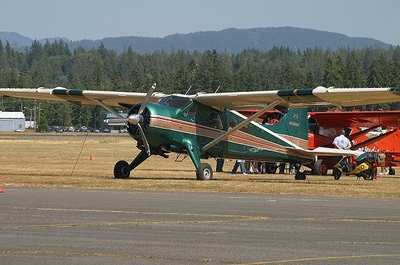Tue, Dec 21, 2021
AD 2021-24-18 Requires Determining Service Life Limits For The Wing Strut Fitting On The Main Spar
The FAA is adopting a new airworthiness directive (AD) for all Viking Air Limited Model DHC-3 airplanes.

This AD results from mandatory continuing airworthiness information (MCAI) originated by an aviation authority of another country to identify and correct an unsafe condition on an aviation product. The MCAI identifies the unsafe condition as fatigue damage of the wing strut lug fitting components and the fuselage to wing strut attachment (tie-bar). This AD requires determining service life limits for the wing strut fitting on the main spar and for the tie-bar and following instructions for removal and replacement of affected parts. The FAA is issuing this AD to address the unsafe condition on these products. This AD is effective January 24, 2022.
Supplementary Information: The FAA issued a notice of proposed rulemaking (NPRM) to amend 14 CFR part 39 by adding an AD that would apply to all Viking Air Limited Model DHC-3 airplanes. The NPRM published in the Federal Register on June 28, 2021 (86 FR 33916). The NPRM was prompted by MCAI originated by Transport Canada, which is the aviation authority for Canada. Transport Canada has issued AD CF-2017-29, dated August 24, 2017 (referred to after this as “the MCAI”), to correct an unsafe condition for Viking Air Limited Model DHC-3 airplanes.
The MCAI states:
- It has been determined that the current maintenance program does not adequately address potential fatigue damage of the wing strut lug fitting components or the fuselage to wing strut attachment (Tie Bar). Affected parts must be replaced before specified air time limits are reached to avoid fatigue cracking of the affected parts. Cracking which is not detected may compromise the structural integrity of the wing or the Tie-Bar.
- Fatigue damage occurs more rapidly on aeroplanes that are operated at higher gross weights. For that reason, the corrective actions of this [Transport Canada] AD must be accomplished sooner for aeroplanes that have been certified for operation at higher gross weights.
- Fatigue damage also occurs more rapidly on aeroplanes that are operated below 2000 feet above ground level (AGL) over land due to higher and more frequent gust and maneuvering loads. Low level flights over water are not known to produce increased fatigue damage on the DHC-3. For that reason, the corrective actions of this [Transport Canada] AD must be accomplished sooner for aeroplanes that have been operated at low altitudes over land.
This condition, if not addressed, could result in cracking and failure of the structural integrity of the wing or the tie-bar.
You may examine the MCAI in the AD docket at https://www.regulations.gov by searching for and locating Docket No. FAA-2021-0214.
In the NPRM, the FAA proposed to require determining service life limits for the wing strut fitting on the main spar and for the tie-bar and following instructions for removal and replacement of affected parts. The FAA is issuing this AD to address the unsafe condition on these products.
More News
“This vote sends an undeniable message to Air Transat management: We are unified, resolute, and have earned a contract that reflects today’s industry standards, not the>[...]
Aero Linx: Beech Aero Club The Beech Aero Club (BAC) is the international type club for owners and pilots of the Beech Musketeer aircraft and its derivatives, the Sport, Super, Sun>[...]
While Landing In The River, The Extended Landing Gear Contacted The Water And The Airplane Nosed Over, Resulting In Substantial Damage Analysis: The pilot of the amphibious airplan>[...]
From 2022 (YouTube Edition): Carrying the Legacy of The B-29 For Generations to Come We had a chance to chat with the Executive Director of B-29 Doc, Josh Wells, during their stop >[...]
Also: Cosmonaut Kicked Out, Airbus Scales Back, AF Silver Star, Russian A-60 Clobbered A Samaritan’s Purse humanitarian flight was hijacked on Tuesday, December 2, while atte>[...]
 Aero-News: Quote of the Day (12.07.25)
Aero-News: Quote of the Day (12.07.25) ANN's Daily Aero-Linx (12.07.25)
ANN's Daily Aero-Linx (12.07.25) NTSB Final Report: Lafferty Jack Sea Rey
NTSB Final Report: Lafferty Jack Sea Rey Classic Aero-TV: The B29 SuperFortress Doc - History in Flight
Classic Aero-TV: The B29 SuperFortress Doc - History in Flight Airborne 12.08.25: Samaritans Purse Hijack, FAA Med Relief, China Rocket Fail
Airborne 12.08.25: Samaritans Purse Hijack, FAA Med Relief, China Rocket Fail



